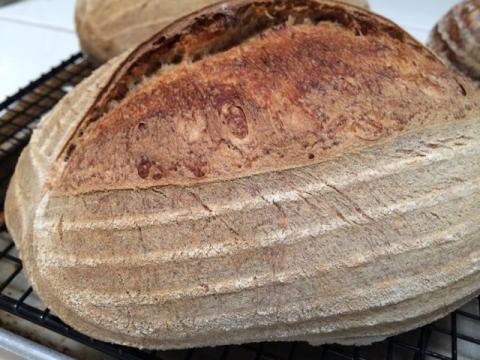Reblogged from: http://wildeconomies.wordpress.com/2014/04/30/interview-with-olivier-part-3/
(Part 1) & (Part 2)
We went a bit off topic after the point where I left off, so, getting back to things…
Olivier: We can’t get to everything in one day, you should come back this summer, to see the mill and the other things we have going on here.
Me: You use a stone mill?
Olivier: Yep, stone mill, it’s about five kilometers from here, at my friend’s place. I use that, I can’t do everything here by myself so I’ve got Raphael (his neighbor) and his mother and father who help with things.
Me: Do you make bread too?
Olivier: Not really but I can. We’ve got flour here after all! I’ll give you some before you go, I can give you a bag of durum flour.
Me: Really! I’d love that. (Note: I was sent away with three kilos plus two bags of the pasta the intern was weighing out. The flour’s already been made into dough, slow-proofing in the fridge right now to be baked this afternoon. Report to come.) You know, I also had some questions about quantities when you’re growing wheat… so for, say, one hectare, I imagine that it depends, what sort of quantity of wheat do you wind up with?
Olivier: An old wheat variety … harvesting or planting?
Me: Harvest.
Olivier: Harvesting, right. If it’s good land, one ton up to four tons.
Me: Seriously!
Olivier: Yeah, four tons the hectare, normally I can manage that. But we seed five kilos. So with five kilos of seed, I can get four tons of harvest. But with some other varieties, I’ll get two tons. The more ancient the species, the smaller the harvest. Plus you’ve got to adapt the cultivation methods.
Me: And so then with conventional wheat?
Olivier: Conventional wheat? Modern, you mean?
Me: Yeah.
Olivier: With modern wheat I’ve managed to get up to eleven tons the hectare. Big difference.
Me: It is. Understandable why most farmers plant the modern varieties.
Olivier: And with the modern varieties you have to treat the fields. Two herbicides, two fungicides, a fertilizer, that makes five products you’ve got to put on the cultivation.
Me: Do you use any of that?
Olivier: Nothing with the ancient grains. Down at the end of the fields, where I have the conventional wheat, I use one herbicide. But it’s still better than organic, because for an organic label you can use more products than that, but I don’t.
Me: And you’re interested in getting organic labeling?
Olivier: Not at all. I know what I’m doing, so why bother? You can go buy an organic vacuum cleaner if you want, what does organic really mean?
Me: Ha, well I’m asking, because in the US it costs a bit of money for a farmer to get organic labeling, so you’ve got some people farming in a way that is very much “organic” but they don’t have the label because they can’t or don’t want to handle the cost, deal with the bureaucracy. And anyway there are such huge loopholes in the regulations for what qualifies as organic that the label is really pretty much meaningless.
Olivier: Exactly, and that’s why I say to myself that, ethically, even if it could be a help for financial security, I don’t do it. I’ve got my clients who come here, and they deal with me, no one else. No dealing with stores, everything works directly between them and me.
Me: How did that come about?
Olivier: Just does. Someone develops allergies or gets sick from the mass produced stuff and they find me, and they tell other people. (True — since my afternoon with Olivier I’ve given his name to three people I know who have problems with gluten.) Word of mouth, at a human scale. If you’re my client and you come to me today, I’ll tell you come back in July and I’ll show you, that wheat there, that field there, you see it, you’re going to eat it, it’s going to pass through your body in six months. Big difference from going to one of these massive grocery stores – doo doo doo! Aisle five, 50% off all our flour!
You know I say all this, I was deep into intensive farming before, and the more I intensified the production, the less I got paid for my product. I said to myself, those people don’t need us. If they’re going to do it like that, they have no need for me, so I’m going to do it without them. If everyone like us turned our backs on the powers, if we stopped giving importance to the people in charge, they’d have no power. It’s because we give them importance that they have power. But if you turn your back on them, they’re no longer important.
Me: Something I ask myself — I’m in total agreement with you, and there are some people who think like this too, but there’s a majority of people who don’t. I agree that it’s not possible to force a change in people’s ideas –
Olivier: No.
Me: But at the same time, if there’s no effort to discuss with “the others” it stays in the realm of “I change myself,” and we don’t change anything at a larger scale.
Olivier: Right, but for example, you heard about me on the radio. (I did, here.)
Me: Yes.
Olivier: If you hadn’t, you wouldn’t have found me.
Me: True.
Olivier: So I invest myself in this, I try to start conversations.
Me: No! I didn’t say you didn’t.
Olivier: No, no, I know that’s not what you’re saying. I’m saying that when I started, I was all alone. By myself with my wheat and a couple friends down the road. Today what do we have? We’ve got heritage wheat growing over there, another span of fields a bit farther away –
Me: Your neighbors are changing too?
Olivier: Some of them are, sure. When I started I had 4,000 square meters myself, now there are twenty hectares, or fifteen maybe, in the area. And more and more people are doing it. So right now, compared to five years ago, there is so much more. And the people who come here to buy from me, at the beginning I had one or two, and now I’ve got people coming every week. Some of them come and buy twenty kilos, some of them don’t go to the grocery store at all anymore. People who before couldn’t eat wheat bread and now they can, and they’re in good health. My friend with the mill, I went by the last time to ask how much I owed him for the milling, and he said, “This time it’s on me, because you gave me something else with what you’re doing. I’ve been having to take hypertension medication for so long and since I’ve been eating the grains you grow I haven’t needed to take anything. Since I started eating differently, I’ve been able to stop my medication. I feel good in my body.” That’s the way it is.
(to the intern, who was still working to fill up bags of pasta for sale) You like pasta?
Intern: Yep.
Olivier: Ho! Then it’s Carnevale for you today. And you know, with that pasta, you eat less than you would of the other stuff. Sticks to your ribs.
(to me) You like bread?
Me: I love it.
Intern: I’m getting tired.
Olivier: Looks like an office in here. Speaking of class warfare, you’ve got the class that fills up the pasta bags and the class that sits around and watches haha.
Me: Have pity on the worrrking man!
Olivier: Poor thing. At least she’s working at something that makes sense. No, but seriously, you know, as far as the goal of the farmer: I’ve been in conferences before where they always finish up by saying, “Ohh but why does organic cost more than conventional, why don’t we have it the other way around since it costs less to produce organic since we aren’t buying chemicals and fertilizers blah blah blah. The farmers must feed the world blah blah blah.” And I say, no. No no no no. This is not the issue we should be talking about. We should be discussing why we don’t live in a world where everyone is able to get by individually at basic things. Everyone should have the right to a bit of land, and be able to grow things for himself or herself and a family. It’s shouldn’t be put on the shoulders of only a few to feed everyone else, no. Everyone should have the capacity to be responsible for his own food, and then people wouldn’t need as much money, which doesn’t have any inherent value anyway. It’s just paper, founded on nothing really. We’re the ones who give it value. We live in a world where it’s completely the opposite of how it should be. In the big cities, you need money to live! People in cities can’t support themselves. But if everyone had just a little plot of space to grow things to eat, and knew what to do with it, we’d change a lot about how we live.











